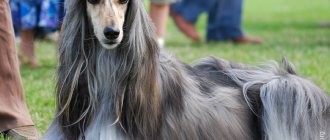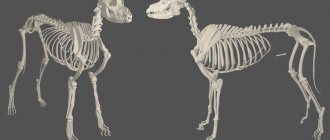Monitoring dog development
If the pet is purchased from a breeder, there is no need to monitor height and weight. To determine when a dog will be considered an adult, it is enough to meet its parents. For professional breeders, this procedure is mandatory even before handing over the puppy. But when the dog is a mongrel from a shelter or from the street, then you need to ask yourself what parameters to expect. It's almost impossible to predict; mongrel crosses are unpredictable.
Post different breeds
To understand to what age puppies grow, regular weighing and measurement of dimensions are required. Up to 2 months this is done on average once every 5 days, from 2 to 6 months - every 10 days, and then once a month is enough.
What to measure:
- standing height at withers;
- paw circumference;
- chest girth;
- height to the elbow.
Basic patterns of rocks
To what age do cats grow - regular and purebred?
Each species has a different period of full maturity. Below is a look at when dogs stop growing in the most common breeds:
- the German shepherd, like the husky, actively develops up to one year, and until two years of age it develops until it reaches full maturity;
- in a Rottweiler, growth ends by the age of one year, the muscles are finally formed at 2.5 years;
- the Yorkshire Terrier becomes fully mature at eight months;
- the dachshund develops up to 8 months and then grows only in width;
- Pugs grow from 5 to 9 months;
- in the Pekingese, maturation depends on gender: the male develops up to a year, the female develops faster, up to 8 months;
- The toy terrier is the fastest developing dog; full maturity is completed by 5 months.
For your information! In nature, there is such a variety of dogs as mestizo, which is neither a purebred nor a mongrel. No one can predict the growth of these individuals.
What does a mestizo look like?
Prenatal period
Calcium for dogs of large, small and medium breeds
The period of development inside the womb is divided into several parts. The first stage is completed by the 18th day, development occurs due to food reserves. Next, the liver and kidneys are formed and blood circulation starts.
In the second stage, signs of pregnancy appear in the mother dog. The embryo takes on the shape of a mammal. The nose, eyes, jaws, limbs are formed, the fetus is rapidly increasing. At the end of this period, almost all formation ends, but hair does not appear.
During the last third period, the main growth process takes place: the development of the brain, respiratory tract, bone skeleton, digestion and genital organs.
Stages of development and growth
Any animal, before becoming an adult, goes through stages during which noticeable changes occur.
Embryo
Small breed food for puppies as well as large and medium breeds
During this period, the puppy is still in the womb, and there is no contact with the outside world. At this time, the main thing is to take care of the mother and her condition.
Note! The kind of food the dog is given determines what kind of baby the baby will be born and its future health.
suckling baby
After birth, it is very important that the puppy is breastfed. It lasts, depending on the breed, from a couple of weeks to 1.5 months.
Puppy
During this period, breeders give the dogs to their new owners; they are already weaned. This stage lasts from 1 to 6 months. The puppy is actively growing, his teeth are changing. At this time, you need to monitor his nutrition and health (it is important to get vaccinated and treat for possible parasites).
Young animals
From six months to one year, the dog enters adolescence. The puppy is very playful and stubborn at this time. Right now he needs to be educated or given to professionals for training.
Juvenile
By the age of 1 year, almost all dogs have gone through puberty. In appearance, they are no different from an adult, but if it is a large breed, then final maturation will occur by 2 years. It is for this reason that crossing is allowed no earlier than 2 years after birth.
Note! Little puppies that are often sad and lonely develop less well than their happy counterparts. The first months are considered the most stressful for the animal, so it is necessary to devote maximum time and be patient.
Peculiarities of puppies growing up
Each puppy, regardless of breed, grows up according to several similar principles. There are two main periods, which are accompanied by their own developmental characteristics - before six months and after.
Puppies up to six months
Newborn puppies grow the most actively, since by six months they need to increase in weight three times (compared to their parameters at birth), and also double in height. Up to six months, puppies grow exclusively in height (if they are not overfed).
It is important for puppies up to six months to have foods in their diet that help strengthen bones.
The main danger that awaits the puppy at this stage is incorrectly formed tubular bones. This type of bone continues to grow for several months after the puppy is born, so it is important for the owner to ensure that they develop properly. You can help your animal’s body with a balanced diet that contains the following microelements:
- calcium;
- phosphorus;
- magnesium.
One of the main sources of calcium for a puppy is fermented milk products.
In some cases, veterinarians may prescribe vitamin supplements containing the above elements. However, it is not recommended to give your puppy any supplements without appropriate indications.
Puppies older than six months
Six months after birth, the puppies' chest bone begins to enlarge due to the active growth of flat bones, as a result of which the pet becomes visually wider. Such changes occur at a rapid pace until the age of one, and then slow down significantly.
After six months, external changes in the appearance of puppies become less noticeable
However, despite all the invisibility of subsequent development, the animal will need at least three years for all its bones to be fully formed. As already mentioned, this is important to take into account for those owners who want their pets to take part in mating.
How old do dogs of different breeds grow?
The main difference between the maturation of different breeds is that a small breed matures faster, and a large breed takes longer. But you need to at least approximately know how many months dogs grow and the characteristics of each breed in order to track the development of the pet.
Important! In addition to differences in development between breeds, dogs of the same breed but with different sex characteristics also develop differently.
Small breeds
How small dog breeds develop:
- The toy terrier stops growing at the age of 4 months and becomes the size it will be throughout its life;
- the Yorkshire terrier, or Yorkie, grows up to 5 months, then only gains muscle mass;
- Pugs grow from 5 to 9 months;
- Dachshunds grow in length up to 8 months and then only in width.
Small breeds develop faster
Medium dogs
Medium-sized dogs develop and mature at the same rate - from 10 months to 1 year. Some then only gain muscle mass.
Large individuals
The fastest growing large dog breed is the German Shepherd, which grows within a year. But the Irish Wolfhound grows up to 2 years, but after that it still gains muscle mass.
Walks
Readers have guessed what is meant by physical activity. Of course, regular walks. This does not mean that as soon as the puppy appears in the house, he is immediately dragged outside. No, a second vaccination is given first if the breeder has not given one. After this, five days pass, and the baby can be taken out.
The first walks are short but frequent. After each feeding, the puppy is taken outside to do its business. The older the pet, the longer the walks become.
Large breed dogs are given full walks from the age of three months. A German Shepherd puppy, for example, will not mind being outside for half an hour. If the weather is warm, walk longer and more often.
End of growth in different breeds
Each breed completes growth and development differently, it all depends on growth, characteristics, habitat, nutrition:
- a yard dog, or as it is jokingly called a yard terrier. Due to the mixing of breeds, it is difficult to determine when such a dog will finish growing and what size it will reach. How long it will grow can be determined by external signs: if a large breed predominates, then the pet will grow large. Another factor is the size of the baby’s paws: the more massive the baby’s paws are, the larger he will grow and vice versa. If the mongrel is large, then it will grow up to 12 months, small - up to 8 months;
- the German Shepherd stops growing at 1 year;
- the Yorkshire Terrier can grow in 6 months and then only gains muscle mass;
- Pomeranian Spitz grows up to 6 months, after which bones become stronger;
- Great Dane grows up to 1.5 years and then gains weight up to 3 years;
- The mini toy terrier grows faster than all other breeds; by 4 months it becomes fully mature;
- The Chihuahua grows up to 8 months, then the skeleton only gets stronger;
- in a Labrador, growth ends at 1.5 years; at 2.5 years, the bones and muscles are finally formed;
- the husky completes development by 10 months;
- a boxer will mature by 1 year;
- the spaniel grows until about 8 months, then we gain muscle mass until 1.5 years;
- Beagles stop growing at 8 months.
How to find out your pet's future size
If you become the owner of a mongrel, but know nothing at all about its parents, then you can try to calculate the approximate future size. To do this, you need to multiply the weight of a 4-month-old puppy by 2 or divide the current weight by the age in weeks and multiply by 52. Both methods do not guarantee 100% accuracy, but at least you will get approximate values.
IMPORTANT!
If a four-legged baby found on the street was severely emaciated, then until normal muscle mass is gained, its weight cannot be taken as a guide for calculations.
Many dog lovers often recommend another method - determining future sizes by the size of the paws. There is no point in following them. After all, a puppy’s large paws do not mean that he will become a giant. With a much higher probability, this external sign is explained by uneven development of the body in the first 4 weeks of life.
Factors that influence animal performance
Like any creature, development is influenced by care, feeding, attitude, and activity. In order for your pet to grow up cheerful and healthy, you need to devote the same amount of time to him as you would to a small child:
- nutrition. Your puppy should eat plenty of fiber and protein. Vitamins must be added to food. Empty cereals, cheap food and bones are not the best option;
- loads. Training should begin gradually with the simplest tasks, adding and teaching new, more complex ones in stages. For example, the Estonian hound begins to be trained at 1.5 months;
- activity. Dogs need long walks to become familiar with the world around them and other animals. At first, walks should be taken every time after eating food, but over time, 2 times a day will be enough;
- diseases. It is necessary to see a veterinarian because puppies are very susceptible to various diseases.
Lack of weight: what to do?
Being underweight is no less dangerous than being overweight. Check the puppy weight chart by month.
If the ribs and spine of the toy terrier are noticeable even without palpation, then the dog is unhealthy thin.
If the puppy has stopped gaining weight, it is recommended:
- Give the puppy anti-helminth medications. When parasites are inside an animal, they prevent nutrients from being absorbed and suck them out themselves.
- Try giving your puppy more exercise. Play with him more often, take him for a walk.
- Increase the portion. Or increase the number of meals.
- Read the composition of the food. Meat ingredients should come first, not cereals. Buy food from the premium segment, marked “for puppies”.
- Contact your veterinarian. Weight loss is a symptom of diseases, such as hepatitis, cancer or inflammatory processes in organs.
What to feed a puppy for growth
The main thing that affects the growth and development of a puppy is nutrition. It is best to choose a diet for your pet together with a dog handler.
Which food is better
A puppy up to 3 months should eat 6 times a day, after which it can be switched to 4 meals a day, and from 6 months - to two meals a day.
Important! An animal gains muscle mass from the age of 6 months, so dog food should be balanced, rich in proteins, microelements and vitamins.
You can choose two food options: natural products or ready-made food. But it is best to mix both types of feeding to achieve ideal feeding.
It doesn’t matter what breed a person chooses for himself, it is important how he will treat the pet, monitor its health, development and nutrition. If the pet will not perform at exhibitions and participate in competitions, there is absolutely no need to know the exact parameters of the animal. The main thing is that this is the most faithful and devoted friend who needs a person and his love.
Advantages of mongrels
People who want to get a reliable friend and companion will like mongrels, and in some ways they are even superior to purebred dogs:
- They rarely suffer from hereditary diseases. Almost all mongrel puppies born on the street survive.
- Mutts are highly trainable. They do not have a built-in pattern with fixed instincts, like purebred dogs.
- Outbred dogs are distinguished by their endurance and unpretentiousness in food.
- They are unique - it is difficult to find two identical mongrels.
- The devotion of these dogs to their owner knows no bounds. Until his last days they will adore him, expressing great feelings of love and affection.
- In the role of a watchman or security guard, the mongrel is in no way inferior to purebred dogs.
Of course, in turn, each individual dog has its own specific advantages and disadvantages.











